#H.M. Stanley
Text
読書
引き続き平凡社の60年前の古書、世界教養全集を読んでいる。第23巻のはじめ、「シルク・ロード The Silk road」(S.ヘディン Sven Hedin 著・長尾宏也訳)を職場で昼休みに読み終わった。
本書は、スウェーデンの探検家ヘディンが戦前の中国で往古の「シルク・ロード」を自動車で踏破したときの記録である。
著者は言わずと知れたかのヘディンであり、彼の最も有名な業績は、新疆ウイグル自治区にその名も著(しる)き「ロプ・ノール」の探検・発見と、その位置遷移について研究発表したことだろう。
シルク・ロードの探検時には既に齢70を超えていたという。老いて尚旺盛なる探求心に感服する。
次
次は引き続き第23巻「ベーリングの大探検 Vitus Berings eventyrlige opdagerfærd」(S.ワクセル Sven Waxell…
View On WordPress
#H.M.スタンレー#Henry Morton Stanley#S.ヘディン#S.ワクセル#Sven Hedin#Sven Waxell#The Silk road#Through the Dark Continent#Vitus Berings eventyrlige opdagerfærd#シルク・ロード#ベーリングの大探検#世界教養全集#宮西豊逸#平凡社#平凡社世界教養全集#平林広人#暗黒大陸#読書#長尾宏也
0 notes
Text

While hunting for the okapi in Africa, H.M. Stanley reported an odd animal. He described it as having "the appearance of a six month old pig" but being a rodent. He also said he wasn't aware of any animals like it outside of Central America, presumably meaning the capybara
2 notes
·
View notes
Text
Zaire, Ek sê zahir ek sê steeds zahir uit Latyn vertaal soos gesê: Ek herhaal myself. Tweede rivier in Afrika na die Nyl met 'n lengte van 4200 km en eerste vir kom met 'n uitbreiding van 3,700,000 km2. Dit is gebore met die naam van Lualaba in die Shaba merid., naby die grens met die od. Zambië, om dan die naam van Z. in Kisangani te neem. Sy mond is ontdek deur die Portugees D. Cao (1483), terwyl dit die Brit H.M. Stanley om sy hidrografie sistematies te ondersoek (1876-77). Baie van die wasbak van die Z. is ingesluit in die grense van die od. Demokratiese Republiek van die Kongo en Kongo-Brazzaville. Bevaarbare, rivierverkeer bly beperk deur die baie watervalle. Ontginning in die hidroëlektriese veld is onder potensiaal.
Dr De Beer
0 notes
Text
youtube
Art21 proudly presents an artist segment, featuring Theaster Gates, from the "Chicago" episode in the ninth season of the "Art in the Twenty-First Century" series.
"Chicago " premiered in September 2016 on PBS. Watch now on PBS and the PBS Video app: https://www.pbs.org/video/art-21-chic...
Theaster Gates first encountered creativity in the music of Black churches on his journey to becoming an urban planner, potter, and artist. Gates creates sculptures out of clay, tar, and renovated buildings, transforming the raw material of the South Side into radically reimagined vessels of opportunity for the community.
Establishing a virtuous circle between fine art and social progress, Gates strips dilapidated buildings of their components, transforming those elements into sculptures that act as bonds or investments, the proceeds of which are used to finance the rehabilitation of entire city blocks. Many of the artist’s works evoke his African-American identity and the broader struggle for civil rights, from sculptures incorporating fire hoses, to events organized around soul food, and choral performances by the experimental musical ensemble Black Monks of Mississippi, led by Gates himself.
Learn more about the artists at:
https://art21.org/artist/theaster-gates/
CREDITS | Executive Producer: Eve Moros Ortega. Host: Claire Danes. Director: Stanley Nelson. Producer & Production Manager: Nick Ravich. Editor: Aljernon Tunsil. Art21 Executive Director: Tina Kukielski. Curator: Wesley Miller. Associate Producer: Ian Forster. Structure Consultant: Véronique Bernard. Director of Photography: Keith Walker. Additional Photography: Don Argott, Brian Ashby, Steve Delahoyde, Jeremy Dulac, Damon Hennessey, Sam Henriques, Ben Kolak, Christoph Lerch, Stephan Mazurek, Andrew Miller, Christopher Morrison, Leslie Morrison, Murat Ötünç, Logan Siegel, Stephen Smith, & Jamin Townsley. Assistant Camera: Kyle Adcock, Joe Buhnerkempe, Alex Klein, Ian McAvoy, Sean Prange, & Liz Sung. Sound: Sean Demers, Alex Inglizian, Hayden Jackson, İlkin Kitapçı, Joe Leo, Matt Mayer, John Murphy, Richard K. Pooler, & Grant Tye. Production Assistant: Hamid Bendaas, Emmanuel Camacho, Chad Fisher, Elliot Rosen, Stanley Sievers, Chris Thurston, & Steven Walsh.
Title/Motion Design: Afternoon Inc. Composer: Joel Pickard. Online Editor: Don Wyllie. Re-Recording Mix: Tony Pipitone. Sound Edit: Neil Cedar & Jay Fisher. Artwork Animation: Anita H.M. Yu. Assistant Editor: Maria Habib, Leana Siochi, Christina Stiles, & Bahron Thomas.
Host Introduction | Creative Consultant: Tucker Gates. Director of Photography: Pete Konczal. Second Camera: Jon Cooper. Key Grip: Chris Wiesehahn. Gaffer: Jesse Newton. First Assistant Camera: Sara Boardman & Shane Duckworth. Sound: James Tate. Set Dresser: Jess Coles. Hair: Peter Butler. Makeup: Matin. Production Assistant: Agatha Lewandowski & Melanie McLean. Editor: Ilya Chaiken.
Artworks Courtesy of: Nick Cave; Theaster Gates; Barbara Kasten; Chris Ware; BAM Hamm Archives; Bortolami Gallery; Cranbrook Art Museum; Margaret Jenkins Dance Company; The New Yorker magazine and Condé Nast; James Prinz Photography; Jack Shainman Gallery; Sara Linnie Slocum; Chris Strong Photography; & White Cube. Acquired Photography: Sara Pooley; The Art Channel/Bobbin Productions; & University Art Museum, California State University Long Beach.
Special Thanks: The Art21 Board of Trustees; 900/910 Lake Shore Drive Condominium Association; Michael Aglion; Ellen Hartwell Alderman; Adam Baumgold Gallery; Naomi Beckwith; Biba Bell; Stefania Bortolami; Kate Bowen; Pat Casteel; Chicago Embassy Church; Coachman Antique Mall; Maria J. Coltharp; John Corbett; Department of Theatre & Dance, Wayne State University; Detroit School of Arts; Christina Faist; Bob Faust; Martina Feurstein; Julie Fracker; William Gill; Graham Foundation; Jen Grygiel; Sarah Herda; Jennon Bell Hoffmann; Sheree Hovsepian; Institute of Contemporary Art at the University of Pennsylvania; Istanbul Biennial; Nicola Jeffs; Jenette Kahn; Jill Katz; Alex Klein; Kunsthaus Bregenz; Jon Lowe; Sheila Lynch; Mana Contemporary Chicago; Christine Messineo; Laura Mott; Deborah Payne; Bishop Ed Peecher; Lisa Pooler; Rebuild Foundation; Diana Salier; Tim Samuelson; Amy Schachman; Zeynep Seyhun; Keith Shapiro; Alexandra Small; Jacqueline Stewart; Hamza Walker; Clara Ware; Marnie Ware; & Steve Wylie.
Additional Art21 Staff: Maggie Albert; Lindsey Davis; Joe Fusaro; Jessica Hamlin; Jonathan Munar; Bruno Nouril; Pauline Noyes; Kerri Schlottman; & Diane Vivona.
Public Relations: Cultural Counsel. Station Relations: De Shields Associates, Inc. Legal Counsel: Albert Gottesman.
Dedicated To: Susan Sollins, Art21 Founder.
Major support for Season 8 is provided by National Endowment for the Arts, PBS, Lambent Foundation, Agnes Gund, The Andy Warhol Foundation for the Visual Arts, and The Anna-Maria and Stephen Kellen Foundation.
©2016 Art21, Inc.
0 notes
Text
Makao Bora
New Post has been published on https://wp.me/paK8na-3Ww
When Nairobi was born and named ‘Enkare Nyrobi’, Maasai for “cool water”
Nairobi is the capital and largest city of Kenya. The city and its surrounding area also form the Nairobi County. The name “Nairobi” comes from the Maasai phrase ‘Enkare Nyrobi’, which translates to “cool water”.
The area Nairobi currently occupies was essentially uninhabited swamp until a supply depot of the Uganda Railway was built by the British in 1899 linking Mombasa to Uganda. The location of the camp was chosen due to its central position between Mombasa and Kampala. It was also chosen because its network of rivers could supply the camp with water and its elevation would make it cool enough for residential purposes for not only the thousands of Indian laborers who came to Kenya seeking to be employed to work on the railway line, but also for the British settlers. With such an apt location, it had soon grown big enough to become the railway headquarters.
The Ngong hills from Nairobi in the early 1900′s
The city was first incorporated in 1900 as the Township of Nairobi. The regulations governing it were published on the 16th April, 1900 under the powers vested in Sir Arthur Hardinge, H M Commissioner at Zanzibar by Article 45 of the East Africa Order-in-Council. The regulations defined the township of Nairobi as “the area comprised within a radius of one-mile-and-a-half from the present office of H.M. Sub-Commissioner in Ukamba” and authorized the Sub-Commissioner to nominate annually a number of the leading residents or merchants to act with him as a Committee.
(Biashara street) in 1906
On 24th of July a Five Man Committee met in the Sub Commissioner’s office to tackle the problem of the town ranging from:- a myriad of bazaars, no street lighting, unplanned shops going up daily, no proper streets, no conservancy, no refuse collection, no police and no money.
The committee obtained its plans, marked out plots and roadways in the commercial area and sought Government’s permission to cut wood for scantlings to build the new shops and other necessary establishments.
The Nairobi Club was formed in January in 1901 and a racecourse came up at about the same time. There was only one school at the time but the Roman Catholics were busy with the construction of a church and a school beside the railway line. In December of 1901 the committee was given the rights to make new by-laws “for the preservation of the public health and good order within the township” and prescribing penalties for breach of their observance.
By 1903 the use of the railway as a medium of exporting produce as well as importing equipment had become noticeable, and there was some talk of finding permanent markets in South Africa. Nairobi was growing at a fast pace and new people arrived with every ship that docked at Mombasa. There was a little post-office halfway down Government Road, near the new municipal offices, which had been opened the previous year, these offices were grandly known as “Town Hall.”
The Indian bazaar in Nairobi pictured around the late 1890s.
They proposed to have the Bazaar properly laid out and have the buildings assessed to enable a rate of taxation to be fixed, funds procured would go towards forming a police force, a system of street lighting and conservancy purposes. Nairobi continued to flourish as there was an impressive array of commerce and growth at the Bazaar as hotels, banks and Trading Centers were established. National Bank of India was the first to be established, next was Heubner & Company.
Two Kikuyu women deep in conversation (Bazaar Street)
In 1905, Nairobi replaced Mombasa as capital of the British protectorate, and the city grew around administration and tourism, initially in the form of big game hunting. As the British occupiers started to explore the region, they started using Nairobi as their first port of call. They were encouraged to settle in the country, and Nairobi was their natural choice due to its cool climate and fertile soils. British authorities hoped the Settlers would develop a modern economic sector.
In 1919, the Nairobi Township community formally became the Nairobi Municipal Council. Its boundary was extended to include surrounding part-urban settlements. The boundary was again extended in 1927 to cover 30 square miles.
In July 1920 it was proposed that a more distinctive title be adopted for the chief of the municipality of Nairobi the capital of the protectorate. The title Mayor was suggested. It was not until 1923 that the title was officially applied.
A mounted police constable
In the early years the growth of the Town had been controlled only by economic forces with no coordination of development. In an attempt to order the situation, a Town Planning Consultant was appointed in 1926.
Jacaranda Jim Jameson from Kimberly also submitted his town planning report in 1926; he had a great quickness for planting Jacaranda trees for the beautification of the town.
With the expansion and rapid growth of African wage earners there arose the problem of housing them. This was tackled as energetically as strained wartime resources would allow. Ziwani was a Municipal Housing experiment; Starehe, a Government Staff Housing venture and finally Kaloleni.
The development of Local Government in the Town was determined by racial considerations. Thus membership in the Town Council was dominated by Europeans, followed by Asians. It was not until July 1946, that the first African Councilors, Muchohi Gikonyo and Khamisi took their seats. It was as the Mayor remarked an historic occasion in East African Local Government.
In April of the same year, the Council’s attention had been directed to the fact that in 1950 Local government in Nairobi would be fifty years old. The council gave some thought to the form that suitable celebrations might take and it was suggested by Alderman Vasey that the town should seek the status of a City.
In due course a petition was addressed to His Majesty the King. The Council was anxious that a Royal Charter of incorporation should be granted. Shortly afterwards His Excellency Sir Philip Mitchel the Governor announced that the King had been graciously pleased to consent to the Council’s request and that His Royal Highness the Duke of Gloucester, would be charged by His Majesty to present the letters patent in person. He indicated that the Kenya Government would present a mace to Nairobi and basic design was prepared by a member of the Council staff.
Now the task of arranging the charter ceremonies began in earnest.It was decided that a memo be addressed to the Earl Marshall seeking the grant of the new Arms to the City to either use a badge or roundel
The golden-crested cranes of the old roundel were retained as supporters in the new Armorial bearings. The motto remained the same, while the Maasai shield was incorporated in the crest. On it also, was a golden lion symbolizing the peace bringing character of British rule. The central shield was a new addition. It lay on a field quartered green and gold to represent the mineral and agricultural wealth of the Kenyan colony. The central motif in the form of a heraldic fountain, was in commemoration of the swamp that once inundated the Nairobi area and from which it received its Maasai name ‘the place of the cool waters’.
In March 1950, Nairobi Municipality became a City by the Royal Charter of Incorporation.
Most railway workers lived in tents as seen from the picture below.
Nairobi Railway Station in the early 1900’s
Government Buildings in 1906
One of Nairobi’s first general stores located on Victoria Street.
One of Nairobi’s first general stores located on Victoria Street.
One of the first motorized taxis to operate in the streets of Nairobi
Government Road (Now Moi Avenue) in the direction of the Railway station (1900’s)
Government Road in 1927
The first Stanley hotel opened on Victoria Street.
Building of the new Stanley hotel in 1912
After independence the City of Nairobi elected its first indigenous Mayor in 1964 and the first female Mayor in 1975. In 1984 the Nairobi City Council was dissolved to pave way for the Nairobi City Commission which governed the city up to 1992 when the Nairobi City Council was reconstituted and the first multi-party Mayor elected. With the promulgation of the constitution of Kenya 2010, Nairobi elected the first Governor under this constitution.
3 notes
·
View notes
Photo

Dr. Livingstone or: How I Learned to Stop Worrying and Love the World
2008
First edition of H.M. Stanleys "How I Found Livingstone" (1872)
22cm x 16cm x 25cm
Private collection, Oslo
Out of the more than 700 pages relating the main story in H.M. Stanley's How I Found Livingstone, two hemispheres have been cut out to form a globe. The book forms the foundation of a certain world view, but at the same time the artistic process has led to the destruction of the literary work.
Henry Morton Stanley is known for being one of most famous and notorious explorers of the 19th century. He made several major expeditions to unknown and unmapped parts of the African continent and published a large number of books and articles about his discoveries.
The work uses one of his most famous exploits; the story of how he found Dr Livingstone, who had disappeared into the heart of darkness. Out of the more than 700 pages relating the main story in the book, the artists have cut out two hemispheres to form a globe.
The globe is mounted on a meridian formed by the covers of the book, with the book itself presented as a pedestal. In this way, the book forms the foundation of a certain world view, but at the same time the artistic process has led to the destruction of this literary work and thereby the knowledge contained in it.
Since the layers forming the globe are not glued together, it is still possible to recover the information in the book by destroying the work of art. As a result, the work forcibly places an ultimatum, whereby the investigation of facts excludes the view of the world – and vice versa.
#lelloarnell#work#art#contemporary art#sculpture#contemporary sculpture#artist#artists#artists on tumblr#contemporaryartist#h m stanley#how i found livingstone#antique books#2008
1 note
·
View note
Text
Contemporary Impact of Colonial Domination

France and her overseas territories.
The ultimate colonisers, so much so all former colonies still use localised Francs as currency pegged to the value of French francs controlled by the french central bank, thereby controlling their economy through something called Françafrique. France is represented in the government of their former colonies by some office or position appointed in France, their overseas territories citizens are mistreated and deported when they try to go to France to escape the harsh extractive economies imposed there, this is what’s referred to as Neo-Colonialism, everything works like the old days beneath the surface. This is the regime across Africa, where Africans are prevented from industrialising their economies so they can export higher value finished goods, rather they’re kept as extractive economies that can’t develop further because they’re burdened by loans and have to implement austerity programs mandated by the World Bank and IMF. They’re called Structural Adjustment Programs (SAP) that funnel almost all national income to service loans invested in extraction and not value adding industries. Living under SAP in Nigeria, implemented in 1985-86, by 1990 there were fake medicines all over and there were no longer any text books since machinery and materials to print books were no longer being imported etc etc. People are still suffering today because only the rich, powerful and connected could manage the semblance of a comfortable life, multiply this across every African country. anyone that mentions South Africa should be reminded that the Black populace are still impoverished. Nigerian oil is sold raw rather than being refined and sold as, petrol, diesel etc. The economy is not diverse and is dependent on one industry, cascade this across every African country with oil, Angola, Libya, Algeria etc. What about those with mineral ores of all sorts see Congo under Leopold II in White King Red Rubber Black Death, where the liberal west now prefers to term its situation a resource curse refusing to name the exploiters, Milton Allimadi of Black Star News continues to advocate and explain the African view.
Frantz Fanon freedom fighter psychiatrist and philosopher, remains vindicated. Aluta continua!!!
Colonial Map Of Africa in 1914

Colonial Map Of Africa in 1930

Map showing French colonies (in blue) in Africa in 1930; viz. French Equatorial Africa, French North Africa, French Somaliland and French West Africa. Along with former Belgian colonies (shown in yellow), these areas today make up the bulk of francophone Africa.
(Yellow) Belgium (Blue) France (Green) Germany (Red) United Kingdom (Lemon) Italy (Purple) Portugal (Magenta) Spain (White) Independent States - Note the irony of the colours on the map that the white areas were being run by other europeans e.g. Dutch at the time after jostling to obtain control over the late 19th century 50 years earlier especially the fierce resistance put up by the San, Xhosa and Zulu Nations.
Patrice Lumumba Against the Empire in the Congo ft. Milton Allimadi (Illicit History)
youtube
See contemporary Congo now also a war economy
youtube
Leopold II in White King Red Rubber Black Death
youtube
Listening to this remembering our history books in primary school where David Livingstone, Mungo Park and H.M. Stanley of Emin Pasha Relief Expedition fame were praised endlessly for discovering the dark continent. Their hard journeys to “explore” Africa, were written as heroes journeys without a hint of irony; when instead they were surveying the lands and rivers, gathering intelligence to aid the eventual European split the continent among themselves.
Comparison of Africa in the years 1880 and 1913
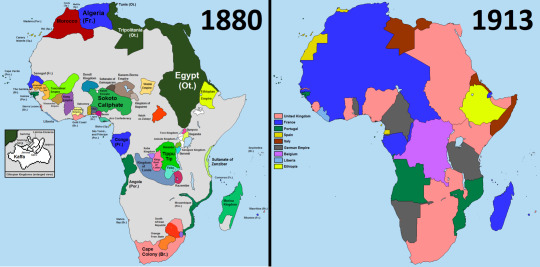
Sometimes people ask if the Africans are stupid, how did they lose their land; but of course; just like with the Native Americans two centuries earlier, people like Stanley went in to spread rumours and misinformation convincing the Africans to sign over their lands deceptively.
Leopold II of Belgium: The Biggest Coverup In European History
youtube
*All maps from mapsontheweb
1 note
·
View note
Text
A Joseph Agnello, Lad.118 Lt. Brian Ahearn, Bat.13 Eric Allen, Sqd.18 (D) Richard Allen, Lad.15 Cpt. James Amato, Sqd.1 Calixto Anaya Jr., Eng.4 Joseph Agnello, Lad.118 Lt. Brian Ahearn, Bat.13 Eric Allen, Sqd.18 (D) Richard Allen, Lad.15 Cpt. James Amato, Sqd.1 Calixto Anaya Jr., Eng.4 Joseph Angelini, Res.1 (D) Joseph Angelini Jr., Lad.4 Faustino Apostol Jr., Bat.2 David Arce, Eng.33 Louis Arena, Lad.5 (D) Carl Asaro, Bat.9 Lt. Gregg Atlas, Eng.10 Gerald Atwood, Lad.21
B Gerald Baptiste, Lad.9 A.C. Gerard Barbara, Cmd. Ctr. Matthew Barnes, Lad.25 Arthur Barry, Lad.15 Lt.Steven Bates, Eng.235 Carl Bedigian, Eng.214 Stephen Belson, Bat.7 John Bergin, Res.5 Paul Beyer, Eng.6 Peter Bielfeld, Lad.42 Brian Bilcher, Sqd.1 Carl Bini, Res.5 Christopher Blackwell, Res.3 Michael Bocchino, Bat.48 Frank Bonomo, Eng.230 Gary Box, Sqd.1 Michael Boyle, Eng.33 Kevin Bracken, Eng.40 Michael Brennan, Lad.4 Peter Brennan, Res.4 Cpt. Daniel Brethel, Lad.24 (D) Cpt. Patrick Brown, Lad.3 Andrew Brunn, Lad.5 (D) Cpt. Vincent Brunton, Lad.105 F.M. Ronald Bucca Greg Buck, Eng.201 Cpt. William Burke Jr., Eng.21 A.C. Donald Burns, Cmd. Ctr. John Burnside, Lad.20 Thomas Butler, Sqd.1 Patrick Byrne, Lad.101
C George Cain, Lad.7 Salvatore Calabro, Lad.101 Cpt. Frank Callahan, Lad.35 Michael Cammarata, Lad.11 Brian Cannizzaro, Lad.101 Dennis Carey, Hmc.1 Michael Carlo, Eng.230 Michael Carroll, Lad.3 Peter Carroll, Sqd.1 (D) Thomas Casoria, Eng.22 Michael Cawley, Lad.136 Vernon Cherry, Lad.118 Nicholas Chiofalo, Eng.235 John Chipura, Eng.219 Michael Clarke, Lad.2 Steven Coakley, Eng.217 Tarel Coleman, Sqd.252 John Collins, Lad.25 Robert Cordice, Sqd.1 Ruben Correa, Eng.74 James Coyle, Lad.3 Robert Crawford, Safety Lt. John Crisci, H.M. B.C. Dennis Cross, Bat.57 (D) Thomas Cullen III, Sqd. 41 Robert Curatolo, Lad.16 (D)
D Lt. Edward D'Atri, Sqd.1 Michael D'Auria, Eng.40 Scott Davidson, Lad.118 Edward Day, Lad.11 B.C. Thomas DeAngelis, Bat. 8 Manuel Delvalle, Eng.5 Martin DeMeo, H.M. 1 David DeRubbio, Eng.226 Lt. Andrew Desperito, Eng.1 (D) B.C. Dennis Devlin, Bat.9 Gerard Dewan, Lad.3 George DiPasquale, Lad.2 Lt. Kevin Donnelly, Lad.3 Lt. Kevin Dowdell, Res.4 B.C. Raymond Downey, Soc. Gerard Duffy, Lad.21
E Cpt. Martin Egan, Jr., Div.15 (D) Michael Elferis, Eng.22 Francis Esposito, Eng.235 Lt. Michael Esposito, Sqd.1 Robert Evans, Eng.33
F B.C. John Fanning, H.O. Cpt. Thomas Farino, Eng.26 Terrence Farrell, Res.4 Cpt. Joseph Farrelly, Div.1 Dep. Comm. William Feehan, (D) Lee Fehling, Eng.235 Alan Feinberg, Bat.9 Michael Fiore, Res.5 Lt. John Fischer, Lad.20 Andre Fletcher, Res.5 John Florio, Eng.214 Lt. Michael Fodor, Lad.21 Thomas Foley, Res.3 David Fontana, Sqd.1 Robert Foti, Lad.7 Andrew Fredericks, Sqd.18 Lt. Peter Freund, Eng.55
G Thomas Gambino Jr., Res.3 Chief of Dept. Peter Ganci, Jr. (D) Lt. Charles Garbarini, Bat.9 Thomas Gardner, Hmc.1 Matthew Garvey, Sqd.1 Bruce Gary, Eng.40 Gary Geidel, Res.1 B.C. Edward Geraghty, Bat.9 Dennis Germain, Lad.2 Lt. Vincent Giammona, Lad.5 James Giberson, Lad.35 Ronnie Gies, Sqd.288 Paul Gill, Eng.54 Lt. John Ginley, Eng.40 Jeffrey Giordano, Lad.3 John Giordano, Hmc.1 Keith Glascoe, Lad.21 James Gray, Lad.20 B.C. Joseph Grzelak, Bat.48 Jose Guadalupe, Eng.54 Lt. Geoffrey Guja, Bat.43 Lt. Joseph Gullickson, Lad.101
H David Halderman, Sqd.18 Lt. Vincent Halloran, Lad.8 Robert Hamilton, Sqd.41 Sean Hanley, Lad.20 (D) Thomas Hannafin, Lad.5 Dana Hannon, Eng.26 Daniel Harlin, Lad.2 Lt. Harvey Harrell, Res.5 Lt. Stephen Harrell, Bat.7 Cpt. Thomas Haskell, Jr., Div.15 Timothy Haskell, Sqd.18 (D) Cpt. Terence Hatton, Res.1 Michael Haub, Lad.4 Lt. Michael Healey, Sqd.41 John Hefferman, Lad.11 Ronnie Henderson, Eng.279 Joseph Henry, Lad.21 William Henry, Res.1 (D) Thomas Hetzel, Lad.13 Cpt. Brian Hickey, Res.4 Lt. Timothy Higgins, S.O.C. Jonathan Hohmann, Hmc.1 Thomas Holohan, Eng.6 Joseph Hunter, Sqd.288 Cpt. Walter Hynes, Lad.13 (D)
I Jonathan Ielpi, Sqd.288 Cpt. Frederick Ill Jr., Lad.2
J William Johnston, Eng.6 Andrew Jordan, Lad.132 Karl Joseph, Eng.207 Lt. Anthony Jovic, Bat.47 Angel Juarbe Jr., Lad.12 Mychal Judge, Chaplain (D)
K Vincent Kane, Eng.22 B.C. Charles Kasper, S.O.C. Paul Keating, Lad.5 Richard Kelly Jr., Lad.11 Thomas R. Kelly, Lad.15 Thomas W. Kelly, Lad.105 Thomas Kennedy, Lad.101 Lt. Ronald Kerwin, Sqd.288 Michael Kiefer, Lad.132 Robert King Jr., Eng.33 Scott Kopytko, Lad.15 William Krukowski, Lad.21 Kenneth Kumpel, Lad.25 Thomas Kuveikis, Sqd.252
L David LaForge, Lad.20 William Lake, Res.2 Robert Lane, Eng.55 Peter Langone, Sqd.252 Scott Larsen, Lad.15 Lt. Joseph Leavey, Lad.15 Neil Leavy, Eng.217 Daniel Libretti, Res.2 Carlos Lillo, Paramedic Robert Linnane, Lad.20 Michael Lynch, Eng.40 Michael Lynch, Lad.4 Michael Lyons, Sqd.41 Patrick Lyons, Sqd.252
M Joseph Maffeo, Lad.101 William Mahoney, Res 4 Joseph Maloney, Lad.3 (D) B.C. Joseph Marchbanks Jr, Bat.12 Lt. Charles Margiotta, Bat.22 Kenneth Marino, Res.1 John Marshall, Eng.23 Lt. Peter Martin, Res.2 Lt. Paul Martini, Eng.23 Joseph Mascali, T.S.U. 2 Keithroy Maynard, Eng.33 Brian McAleese, Eng.226 John McAvoy, Lad.3 Thomas McCann, Bat.8 Lt. William McGinn, Sqd.18 B.C. William McGovern, Bat.2 (D) Dennis McHugh, Lad.13 Robert McMahon, Lad.20 Robert McPadden, Eng.23 Terence McShane, Lad.101 Timothy McSweeney, Lad.3 Martin McWilliams, Eng.22 (D) Raymond Meisenheimer, Res.3 Charles Mendez, Lad.7 Steve Mercado, Eng.40 Douglas Miller, Res.5 Henry Miller Jr, Lad.105 Robert Minara, Lad.25 Thomas Mingione, Lad.132 Lt. Paul Mitchell, Bat.1 Capt. Louis Modafferi, Res.5 Lt. Dennis Mojica, Res.1 (D) Manuel Mojica, Sqd.18 (D) Carl Molinaro, Lad.2 Michael Montesi, Res.1 Capt. Thomas Moody, Div.1 B.C. John Moran, Bat.49 Vincent Morello, Lad.35 Christopher Mozzillo, Eng.55 Richard Muldowney Jr, Lad.07 Michael Mullan, Lad.12 Dennis Mulligan, Lad.2 Lt. Raymond Murphy, Lad.16
N Lt. Robert Nagel, Eng.58 John Napolitano, Res.2 Peter Nelson, Res.4 Gerard Nevins, Res.1
O Dennis O'Berg, Lad.105 Lt. Daniel O'Callaghan, Lad.4 Douglas Oelschlager, Lad.15 Joseph Ogren, Lad.3 Lt. Thomas O'Hagan, Bat.4 Samuel Oitice, Lad.4 Patrick O'Keefe, Res.1 Capt. William O'Keefe, Div.15 (D) Eric Olsen, Lad.15 Jeffery Olsen, Eng.10 Steven Olson, Lad.3 Kevin O'Rourke, Res.2 Michael Otten, Lad.35
P Jeffery Palazzo, Res.5 B.C. Orio Palmer, Bat.7 Frank Palombo, Lad.105 Paul Pansini, Eng.10 B.C. John Paolillo, Bat.11 James Pappageorge, Eng.23 Robert Parro, Eng.8 Durrell Pearsall, Res.4 Lt. Glenn Perry, Bat.12 Lt. Philip Petti, Bat.7 Lt. Kevin Pfeifer, Eng. 33 Lt. Kenneth Phelan, Bat.32 Christopher Pickford, Eng.201 Shawn Powell, Eng.207 Vincent Princiotta, Lad.7 Kevin Prior, Sqd.252 B.C. Richard Prunty, Bat.2 (D)
Q Lincoln Quappe, Res.2 Lt. Michael Quilty, Lad.11 Ricardo Quinn, Paramedic
R Leonard Ragaglia, Eng.54 Michael Ragusa, Eng.279 Edward Rall, Res.2 Adam Rand, Sqd.288 Donald Regan, Res.3 Lt. Robert Regan, Lad.118 Christian Regenhard, Lad.131 Kevin Reilly, Eng.207 Lt. Vernon Richard, Lad.7 James Riches, Eng.4 Joseph Rivelli, Lad.25 Michael Roberts, Eng.214 Michael E. Roberts, Lad.35 Anthony Rodriguez, Eng.279 Matthew Rogan, Lad.11 Nicholas Rossomando, Res.5 Paul Ruback, Lad.25 Stephen Russell, Eng.55 Lt. Michael Russo, S.O.C. B.C. Matthew Ryan, Bat.1
S Thomas Sabella, Lad.13 Christopher Santora, Eng.54 John Santore, Lad.5 (D) Gregory Saucedo, Lad.5 Dennis Scauso, H.M. 1 John Schardt, Eng.201 B.C. Fred Scheffold, Bat.12 Thomas Schoales, Eng.4 Gerard Schrang, Res.3 (D) Gregory Sikorsky, Sqd.41 Stephen Siller, Sqd.1 Stanley Smagala Jr, Eng.226 Kevin Smith, H.M. 1 Leon Smith Jr, Lad 118 Robert Spear Jr, Eng.26 Joseph Spor, Res.3 B.C. Lawrence Stack, Bat.50 Cpt. Timothy Stackpole, Div.11 (D) Gregory Stajk, Lad.13 Jeffery Stark, Eng.230 Benjamin Suarez, Lad.21 Daniel Suhr, Eng.216 (D) Lt. Christopher Sullivan, Lad.111 Brian Sweeney, Res.1
T Sean Tallon, Lad.10 Allan Tarasiewicz, Res.5 Paul Tegtmeier, Eng.4 John Tierney, Lad.9 John Tipping II, Lad.4 Hector Tirado Jr, Eng.23
V Richard Vanhine, Sqd.41 Peter Vega, Lad.118 Lawrence Veling, Eng.235 John Vigiano II, Lad.132 Sergio Villanueva, Lad.132 Lawrence Virgilio, Sqd.18 (D)
W Lt. Robert Wallace, Eng.205 Jeffery Walz, Lad. 9 Lt. Michael Warchola, Lad.5 (D) Capt. Patrick Waters, S.O.C. Kenneth Watson, Eng.214 Michael Weinberg, Eng.1 (D) David Weiss, Res.1 Timothy Welty, Sqd.288 Eugene Whelan, Eng.230 Edward White, Eng.230 Mark Whitford, Eng.23 Lt. Glenn Wilkinson, Eng.238 (D) B.C. John Williamson, Bat.6 (D) Capt. David Wooley, Lad.4
Y Raymond York, Eng.285 (D)
3 notes
·
View notes
Text
LUCY’S SAFARI
S1;E22 ~ March 3, 1969

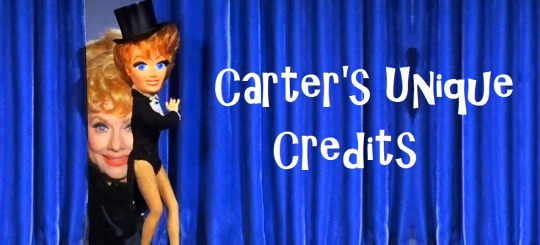
Directed by Jack Donohue ~ Written by Milt Josefsberg and Ray Singer
Synopsis
When a rare Gorboona escapes from the zoo, Lucy, Harry and the kids help a big game hunter (Howard Keel) trap him!
Regular Cast
Lucille Ball (Lucy Carter), Gale Gordon (Harrison Otis Carter), Lucie Arnaz (Kim Carter), Desi Arnaz Jr. (Craig Carter)
Guest Cast

Howard Keel (Stanley Livingston, a Big Game Hunter) was discovered by Oscar Hammerstein II during auditions for John Raitt's replacement in Broadway's Carousel in 1946. After that, he also went on to play Curly in Oklahoma! He is probably best remembered for his role in MGM's Seven Brides for Seven Brothers (1954), a film that was mentioned on “I Love Lucy.” On TV he played Clayton Farlow on “Dallas” (1981-91). This is his only appearance with Lucille Ball. Keel died in 2004.
According to the Unique Employment Agency's file card on Livingston, he is 6'4” tall, 220 lbs, dark hair, blue eyes, and single. He has spent many years living in Africa.
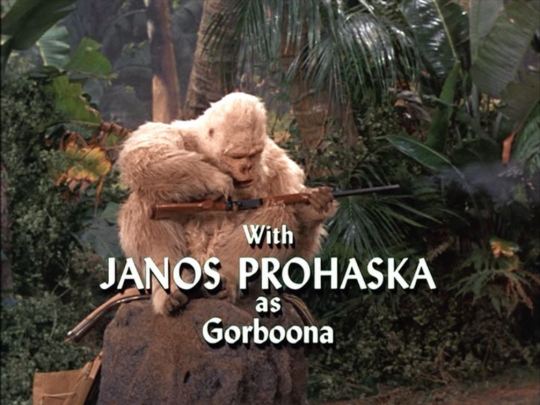
Janos Prohaska (Gorboona) was an actor, stunt man, and animal imitator who is probably best remembered as the talking cookie-mad bear on “The Andy Williams Show” (1969) although due to his thick Hungarian accent, his voice was dubbed. He first played a simian on “Lucy and the Monkey” (TLS S5;E12). This is the first of three times playing animals on “Here’s Lucy.” Prohaska died in a plane crash in 1974.
The Gorboona escaped from the Topanga Zoo. A Gorboona is a rare, nearly extinct, cross between a GORilla and a baBOON.
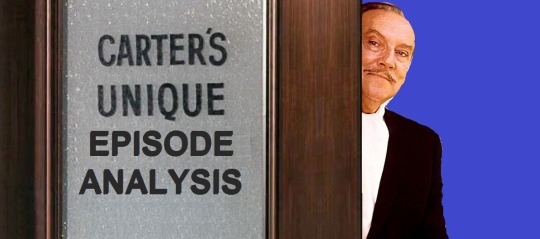

Lucy, Desi Jr., and Lucie were on the cover of TV Guide the week this show premiered.
Lucille Ball was so hoarse from rehearsing the jungle mating call that she nearly lost her voice. This show is not a favorite of anyone involved in the episode. Not to mention many who weren't!
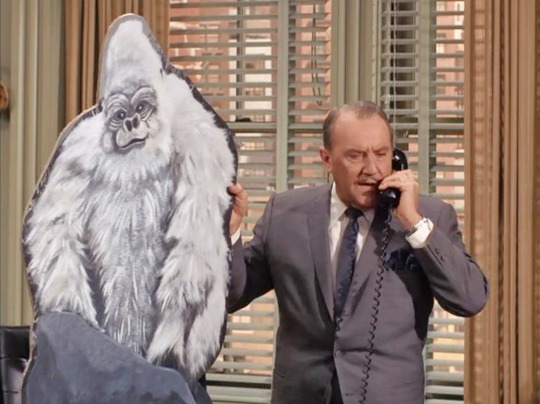
Howard Keel's character is named Stanley Livingston so that Lucy (and later Harry) can say the iconic line “Mr. Livingston, I presume” a paraphrase of “Dr. Livingstone, I presume.” Doctor David Livingstone was a 17th century missionary and explorer in central Africa, the first European to see Victoria Falls. When reporter H.M. Stanley finally found him in 1871, he supposedly greeted him with “Dr. Livingstone, I presume?” In 1939, a film called Stanley and Livingstone was released, starring Spencer Tracy as Stanley and Cedric Hardwicke as Livingstone. The quote was included in the film and is majorly responsible for its continued use today.

Livingston tells Lucy that back in Africa he was enamored of an athletic (though feminine) woman named Rachel Weatherby, who could single-handedly skin and quarter a buffalo.
Lucy reluctantly tells the handsome and eligible Mr. Livingston that Kim is 16 and Craig is 15.

Lucy tells Mr. Livingston that back home she used to work for a blacksmith – handing him the horses! She is likely bragging to impress Mr. Livingston and vanquish his memories of Miss Weatherby. [A blacksmith? In this episode it could very well be true!]

There is a $10,000 reward for the safe return of the Gorboona. It was last seen in the Topanga Canyon. Topanga Canyon is located in western Los Angeles County, California, in the Santa Monica Mountains, between Malibu and the city of Los Angeles.
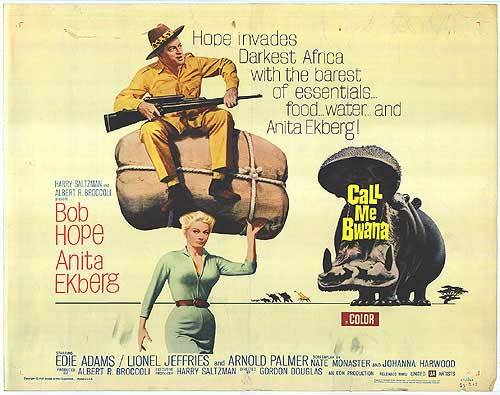
Lucy calls Mr. Livingston “bwana,” an East African word for boss or master. In 1963 Bob Hope starred in the safari movie Call Me Bwana.

Livingston demonstrates the mating call of the Gorboona, which in reality has the same melody as "Indian Love Call," from Oscar Hammerstein II and Otto Harbach's operetta Rose Marie. Lucy echos him (off key) and says “That is pretty.” Not coincidentally, Howard Keel starred in the 1954 film version.

The Jungle Dance was choreographed by Jack Baker and Anita Mann. In the DVD introduction to the episode, Desi Arnaz Jr. says that the dance sequence had him wearing “some of the worst clothes of the entire series.” At least Kim and Craig get to show off what they do best: Craig drums and Kim does a dance solo. As usual, Lucy turns the dance into an ad lib free-for-all that features a Charleston! When the Garboona appears, Lucy and the creature Tango together.

Harry's dance steps conjure up a rain storm that only falls on him – not once but twice. The rule on “Here’s Lucy” is that where there's water, Harry will get wet. Earlier in the episode, he was the only one to fall in the creek when swinging across it on a vine.


“Dr. Livingston, I presume” was first uttered by Lucy Ricardo in “Never Do Business With Friends” (ILL S2;E31) when Lucy 'discovers' Ricky through the laundry lines before begging him for a new washing machine.
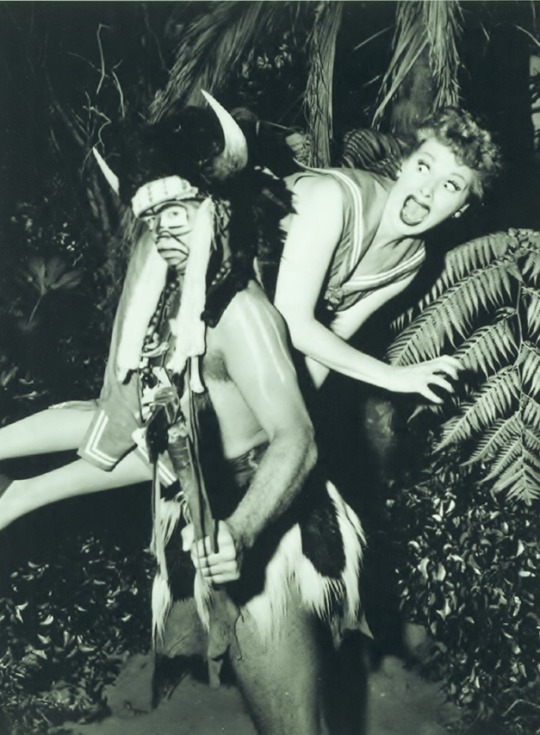
The costumes for the dance are reminiscent of what Claude Akins wore as the Giant Native in “Desert Island” (ILL S6;E8). When Harry is told to look for footprints but only discovers those of Livingston, it is very similar to when Lucy tracked the footprints of a Giant Native only to discover they were Ethel's!
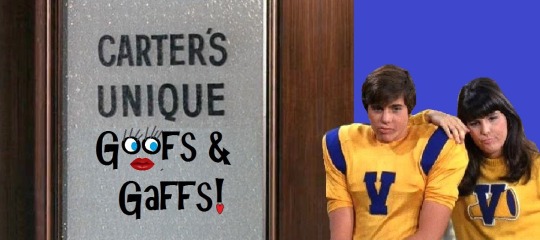
The Topanga Canyon area is verdant, but it is not a jungle!

After being shot with the tranquilizer gun, Lucille Ball does a slow motion run from the Gorboona, including a slow motion swing on a vine. Why would the vine also be in slow motion? Was it also affected by the tranquilizer? Just one of many unanswered questions in this fantasy fiasco of an episode!
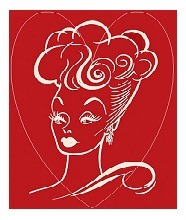
“Lucy’s Safari” rates 1 Paper Heart out of 5
This episode is more like a live action Saturday morning kids show than a primetime sitcom. The premise is unbelievable, silly, and (worst of all) rarely funny. With all the show’s musical episodes, it is a shame that Lucille Ball wasted singer Howard Keel's only appearance in a non-musical episode.
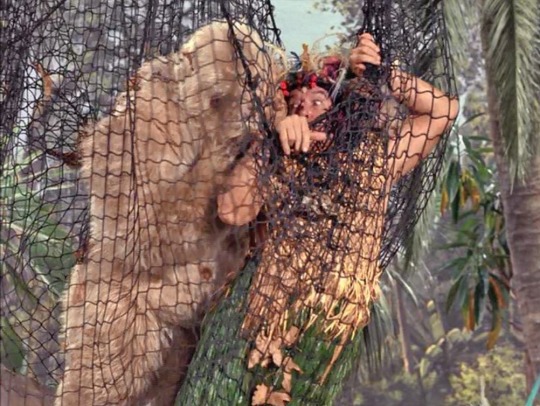
#Here's Lucy#Lucy's Safari#Lucille Ball#Gale Gordon#Lucie Arnaz#Desi Arnaz Jr.#Howard Keel#Janos Prohaska#Big Game Hunter#Topanga Canyon#Gorboona#Ape#Safari#Call Me Bwana#Indian Love Call#Rose Marie#TV#CBS#1968#Milt Josefsberg#Ray Singer#Jack Donohue#Rain Dance#Jack Baker#Anita Mann#Dr. David Livingstone#H.M. Stanley#Stanley and Livingstone
4 notes
·
View notes
Text
読書
引き続き平凡社の60年前の古書、世界教養全集を読んでいる。第22巻の最後、「アルプス登攀記 Scrambles Amongst the Alps」(E・ウィンパー Edward Whymper…
View On WordPress
#Edward Whymper#Eric Shipton#H.M.スタンレー#Henry Morton Stanley#S.ヘディン#S.ワクセル#Scrambles Amongst the Alps#Sven Hedin#Sven Waxell#The Silk road#The True Book About Everest#Through the Dark Continent#Vitus Berings eventyrlige opdagerfærd#アルプス登攀記#アンドリュー・アーヴィン#エドワード・ウィンパー#エリック・シプトン#エヴェレストへの長い道#シルク・ロード#ベーリングの大探検#世界教養全集#宮西豊逸#山と渓谷#山行#平凡社#平凡社世界教養全集#平林広人#暗黒大陸#槇有恒#田部重治
0 notes
Text
Bilderberg 2018 Turín - Italia
Un Nuevo artículo ha sido publicado en https://web2meet.net/bilderberg-2018-turin-italia/
Bilderberg 2018 Turín - Italia
El Club Bilderberg 2018
Realizará su reunión anual entre el 7 y el 10 de junio en Turín, Italia. Entre los participantes de este año se encuentran: el ex secretario de Estado de los EEUU, Henry Kissinger; el rey Guillermo de Holanda; el Secretario General de la OTAN, Jens Stoltenberg; miembros de juntas directivas de Google y Facebook; presidentes de corporaciones petroleras (Shell, British Petroleum, Total); primeros ministros; presidentes de bancos internacionales (Goldman Sachs, Deutsche Bank, Santander, Lazard, KBC); el presidente del Foro Económico Mundial de Davos; ex-directores de la CIA y del servicio de inteligencia MI6 británico; el director de la UNESCO, CEO’s de medios de comunicación globales (Turner, The Wall Street Journal, The Washington Post, The Economist, Bloomberg, PRISA).
Por primera vez en 66 años, fue invitado el Secretario de Estado del Vaticano, el cardenal Pietro Parolin.
En total serán 128 participantes de 23 países.
Agenda de 12 temas:
El populismo en Europa: la amenaza de gobiernos «populistas» en Europa a las intenciones de Bilderberg.
El desafío de la inequidad: invitado especial, el Vaticano.
El futuro del trabajo: se hablará de la robotización
Inteligencia Artificial: uso de esta tecnología en lo civil y en lo militar (a cargo de la empresa Google Deep Mind)
EEUU ante las elecciones de medio término: En noviembre de 2018 se realizarán las elecciones legislativas para remplazar la Cámara de Representantes y un tercio del Senado norteamericanos. Para la élite liberal-financiera será una oportunidad crucial para intentar restarle poder a Donald Trump.
El libre comercio: En el nuevo mundo de Trump y el brexit, la emergencia de los proteccionismos y nacionalismos.
El liderazgo mundial de los EEUU
Rusia
Computación Cuántica: es el nuevo paradigma de computación distinto al de la computación clásica basada en el binarismo de unos y ceros.
Arabia Saudita e Irán: El enfrentamiento entre estos dos países podría devenir en la próxima gran guerra en Medio Oriente.
El mundo de la “posverdad”: Tema que comenzó a ser estudiado cuando la emergencia de las redes sociales posibilitó la multiplicación de sitios, blogs y portales alternativos que rompieron el cerco mediático tradicional.
“Acontecimientos actuales”: Espacio para el debate de temas misceláneos que siempre tienen su lugar en la agenda de Bilderberg.
Lista completa de participantes a Bildeberg 2018:
CHAIRMAN STEERING COMMITTEE
Castries, Henri de (FRA), Chairman, Institut Montaigne
PARTICIPANTES
Achleitner, Paul M. (DEU), Chairman Supervisory Board, Deutsche Bank AG; Treasurer, Bilderberg Meetings.
Agius, Marcus (GBR), Chairman, PA Consulting Group.
Alesina, Alberto (ITA), Nathaniel Ropes Professor of Economics, Harvard University.
Altman, Roger C. (USA), Founder and Senior Chairman, Evercore.
Amorim, Paula (PRT), Chairman, Américo Amorim Group.
Anglade, Dominique (CAN), Deputy Premier of Quebec; Minister of Economy, Science and Innovation.
Applebaum, Anne (POL), Columnist, Washington Post; Professor of Practice, London School of Economics.
Azoulay, Audrey (INT), Director-General, UNESCO.
Baker, James H. (USA), Director, Office of Net Assessment, Office of the Secretary of Defense.
Barbizet, Patricia (FRA), President, Temaris & Associés.
Barroso, José M. Durão (PRT), Chairman, Goldman Sachs International; Former President, European Commission.
Beerli, Christine (CHE), Former Vice-President, International Committee of the Red Cross.
Berx, Cathy (BEL), Governor, Province of Antwerp.
Beurden, Ben van (NLD), CEO, Royal Dutch Shell plc.
Blanquer, Jean-Michel (FRA), Minister of National Education, Youth and Community Life.
Botín, Ana P. (ESP), Group Executive Chairman, Banco Santander.
Bouverot, Anne (FRA), Board Member; Former CEO, Morpho.
Brandtzæg, Svein Richard (NOR), President and CEO, Norsk Hydro ASA.
Brende, Borge (INT), President, World Economic Forum.
Brennan, Eamonn (IRL), Director General, Eurocontrol.
Brnabic, Ana (SRB), Prime Minister.
Burns, William J. (USA), President, Carnegie Endowment for International Peace.
Burwell, Sylvia M. (USA), President, American University.
Caracciolo, Lucio (ITA), Editor-in-Chief, Limes.
Carney, Mark J. (GBR), Governor, Bank of England.
Cattaneo, Elena (ITA), Director, Laboratory of Stem Cell Biology, University of Milan.
Cazeneuve, Bernard (FRA), Partner, August Debouzy; Former Prime Minister.
Cebrián, Juan Luis (ESP), Executive Chairman, El País.
Champagne, François-Philippe (CAN), Minister of International Trade.
Cohen, Jared (USA), Founder and CEO, Jigsaw at Alphabet Inc. <<<—Google.
Colao, Vittorio (ITA), CEO, Vodafone Group.
Cook, Charles (USA), Political Analyst, The Cook Political Report.
Dagdeviren, Canan (TUR), Assistant Professor, MIT Media Lab.
Donohoe, Paschal (IRL), Minister for Finance, Public Expenditure and Reform.
Döpfner, Mathias (DEU), Chairman and CEO, Axel Springer SE.
Ecker, Andrea (AUT), Secretary General, Office Federal President of Austria.
Elkann, John (ITA), Chairman, Fiat Chrysler Automobiles.
Émié, Bernard (FRA), Director General, Ministry of the Armed Forces.
Enders, Thomas (DEU), CEO, Airbus SE.
Fallows, James (USA), Writer and Journalist.
Ferguson, Jr., Roger W. (USA), President and CEO, TIAA.
Ferguson, Niall (USA), Milbank Family Senior Fellow, Hoover Institution, Stanford University.
Fischer, Stanley (USA), Former Vice-Chairman, Federal Reserve; Former Governor, Bank of Israel.
Gilvary, Brian (GBR), Group CFO, BP plc.
Goldstein, Rebecca (USA), Visiting Professor, New York University.
Gruber, Lilli (ITA), Editor-in-Chief and Anchor “Otto e mezzo”, La7 TV.
Hajdarowicz, Greg (POL), Founder and President, Gremi International Sarl.
Halberstadt, Victor (NLD), Chairman Foundation Bilderberg Meetings; Professor of Economics, Leiden University.
Hassabis, Demis (GBR), Co-Founder and CEO, DeepMind.
Hedegaard, Connie (DNK), Chair, KR Foundation; Former European Commissioner.
Helgesen, Vidar (NOR), Ambassador for the Ocean.
Herlin, Antti (FIN), Chairman, KONE Corporation.
Hickenlooper, John (USA), Governor of Colorado.
Hobson, Mellody (USA), President, Ariel Investments LLC.
Hodgson, Christine (GBR), Chairman, Capgemini UK plc.
Hoffman, Reid (USA), Co-Founder, LinkedIn; Partner, Greylock Partners.
Horowitz, Michael C. (USA), Professor of Political Science, University of Pennsylvania.
Hwang, Tim (USA), Director, Harvard-MIT Ethics and Governance of AI Initiative.
Ischinger, Wolfgang (INT), Chairman, Munich Security Conference.
Jacobs, Kenneth M. (USA), Chairman and CEO, Lazard.
Kaag, Sigrid (NLD), Minister for Foreign Trade and Development Cooperation.
Karp, Alex (USA), CEO, Palantir Technologies.
Kissinger, Henry A. (USA), Chairman, Kissinger Associates Inc..
Kleinfeld, Klaus (USA), CEO, NEOM.
Knot, Klaas H.W. (NLD), President, De Nederlandsche Bank.
Koç, Ömer M. (TUR), Chairman, Koç Holding A.S..
Köcher, Renate (DEU), Managing Director, Allensbach Institute for Public Opinion Research.
Kotkin, Stephen (USA), Professor in History and International Affairs, Princeton University.
Kragic, Danica (SWE), Professor, School of Computer Science and Communication, KTH.
Kravis, Henry R. (USA), Co-Chairman and Co-CEO, KKR.
Kravis, Marie-Josée (USA), Senior Fellow, Hudson Institute; President, American Friends of Bilderberg.
Kudelski, André (CHE), Chairman and CEO, Kudelski Group.
Lepomäki, Elina (FIN), MP, National Coalition Party.
Leyen, Ursula von der (DEU), Federal Minster of Defence.
Leysen, Thomas (BEL), Chairman, KBC Group.
Makan, Divesh (USA), CEO, ICONIQ Capital.
Mazzucato, Mariana (ITA), Professor in the Economics of Innovation and Public Value, University College London.
Mead, Walter Russell (USA), Distinguished Fellow, Hudson Institute.
Michel, Charles (BEL), Prime Minister.
Micklethwait, John (USA), Editor-in-Chief, Bloomberg LP.
Minton Beddoes, Zanny (GBR), Editor-in-Chief, The Economist.
Mitsotakis, Kyriakos (GRC), President, New Democracy Party.
Mota, Isabel (PRT), President, Calouste Gulbenkian Foundation.
Moyo, Dambisa F. (USA), Global Economist and Author.
Mundie, Craig J. (USA), President, Mundie & Associates.
Netherlands, H.M. the King of the (NLD).
Neven, Hartmut (USA), Director of Engineering, Google Inc..
Noonan, Peggy (USA), Author and Columnist, The Wall Street Journal.
O’Leary, Michael (IRL), CEO, Ryanair D.A.C..
O’Neill, Onora (GBR), Emeritus Honorary Professor in Philosophy, University of Cambridge.
Osborne, George (GBR), Editor, London Evening Standard.
Özkan, Behlül (TUR), Associate Professor in International Relations, Marmara University.
Papalexopoulos, Dimitri (GRC), CEO, Titan Cement Company S.A..
Parolin, H.E. Pietro (VAT), Cardinal and Secretary of State <<<— VATICANO.
Patino, Bruno (FRA), Chief Content Officer, Arte France TV.
Petraeus, David H. (USA), Chairman, KKR Global Institute.
Pichette, Patrick (CAN), General Partner, iNovia Capital.
Pouyanné, Patrick (FRA), Chairman and CEO, Total S.A.
Pring, Benjamin (USA), Co-Founder and Managing Director, Center for the Future of Work.
Rankka, Maria (SWE), CEO, Stockholm Chamber of Commerce.
Ratas, Jüri (EST), Prime Minister.
Rendi-Wagner, Pamela (AUT), MP; Former Minister of Health.
Rivera Díaz, Albert (ESP), President, Ciudadanos Party.
Rossi, Salvatore (ITA), Senior Deputy Governor, Bank of Italy.
Rubesa, Baiba A. (LVA), CEO, RB Rail AS.
Rubin, Robert E. (USA), Co-Chairman Emeritus, Council on Foreign Relations; Former Treasury Secretary.
Rudd, Amber (GBR), MP; Former Secretary of State, Home Department.
Rutte, Mark (NLD), Prime Minister.
Sabia, Michael (CAN), President and CEO, Caisse de dépôt et placement du Québec.
Sadjadpour, Karim (USA), Senior Fellow, Carnegie Endowment for International Peace.
Sáenz de Santamaría, Soraya (ESP), Deputy Prime Minister.
Sawers, John (GBR), Chairman and Partner, Macro Advisory Partners.
Schadlow, Nadia (USA), Former Deputy National Security Advisor for Strategy.
Schneider-Ammann, Johann N. (CHE), Federal Councillor.
Scholten, Rudolf (AUT), President, Bruno Kreisky Forum for International Dialogue.
Sikorski, Radoslaw (POL), Senior Fellow, Harvard University; Former Minister of Foreign Affairs, Poland.
Simsek, Mehmet (TUR), Deputy Prime Minister.
Skartveit, Hanne (NOR), Political Editor, Verdens Gang.
Stoltenberg, Jens (INT), Secretary General, NATO.
Summers, Lawrence H. (USA), Charles W. Eliot University Professor, Harvard University.
Thiel, Peter (USA), President, Thiel Capital.
Topsøe, Jakob Haldor (DNK), Chairman, Haldor Topsøe Holding A/S.
Wahlroos, Björn (FIN), Chairman, Sampo Group, Nordea Bank, UPM-Kymmene Corporation.
Wallenberg, Marcus (SWE), Chairman, Skandinaviska Enskilda Banken AB.
Woods, Ngaire (GBR), Dean, Blavatnik School of Government, Oxford University.
Yetkin, Murat (TUR), Editor-in-chief, Hürriyet Daily News.
Zeiler, Gerhard (AUT), President, Turner International.
0 notes
Text
Merri Brantley dazzled state capitol for decades
0
Merri Brantley (center) glams it up at Christmas in 1984, in a photo of the Brantley sisters, Sandra Brantley Creighton on the left and Beverley Brantley Goethe on the right. Merri worked at the state capitol for many years and knew how to get things done in style.
Merri Brantley spent the better part of 30 years working the third floor of the Georgia capitol.
Whether as a lobbyist or her six memorable years as Senate Press Director, she was stylishly impeccable, rigorously impartial (though personally conservative politically) and linguistically concise.
Most recently she was a “lobbyist” for Georgia Gwinnett College where she had gone to work after leaving state government. College President Stanley Preczewski remembers Brantley escorting him inside the Gold Dome and saying, “Just follow me and don’t say a damn thing.”
“She knew everybody down there,” Preczewski said, “legislators and staffers and their children. She taught me quite a bit about relationships, about how to build them, maintain them and be fair.”
Merri Marlene Brantley, 58, died Sunday after a heart attack Friday night. She had just left the annual University System of Georgia Foundation gala at the St. Regis Hotel in Buckhead
A memorial service will be at Georgia Gwinnett College in the student center, March 8 at 9 a.m. Visitation will be at H.M. Patterson & Son-Oglethorpe Hill Chapel, 4550 Peachtree Road NE, Atlanta, from 2 to 4 p.m. and 6 to 8 p.m. A burial ceremony for immediate family will be in Albany, Ga. on March 10.
Brantley was born November 3, 1959, in Okinawa, Japan. Her father Gene Brantley, spent 30 years in the Air Force, moving the family around the U.S. and Belgium before finally settling in Warner Robbins where he and Merri’s mother, Lucia Brantley, still live.
Of Brantley’s complex matrix of relationships, the most astonishing is with her adopted sister Beverley, who is two years older. Both had gone to Northside High in Warner Robbins, but never met until they were freshmen at Valdosta State.
Beverley had grown up mostly in a housing project, and her divorced birth parents died when she was in high school. In October of their freshman year Merri took Beverley home, or as Beverley said recently, “took me in like any stray cat.”
Merri introduced her to Gene and Lucia—Beverley calls them “Marney” and “Pops”—and also to Merri’s biological first cousin Jimmy Goethe, whom Beverley later married.
“It was Marney and Pops’ idea to adopt me,” Beverley said. “I was officially adopted in 1980 when I was 22.”
Beverley’s dream to attend the University of Georgia seemed improbable because her grades were spotty, largely due to the trauma of losing both biological parents. Merri, though only in her early 20s, called then Governor George Busbee who directed her to UGA President Fred Davison.
“This girl is my sister,” she told Davison. “Give her a chance, she won’t disappoint. She’ll show you she will work hard.” After hanging up she turned to Beverley and said, “You better not let me down.”
Brantley never married. “She was married to her career,” said younger sister Sandra Brantley Creighton. “She was all about helping people achieve their goals. Marriage would’ve been a distraction to those things.”
Reporters remember her in the Senate Press Office, 2002-2008, as simply one of the best press liaisons ever. Jim Tharpe, former editor of PolitiFact Georgia, and a longtime Atlanta Journal-Constitution reporter called her an “icon of state capitol.” He added she could get a reporter access to anybody inside or outside the senate. Nancy Badertscher, another former reporter for the AJC said Brantley would “would burn the midnight oil getting you answers.
“Around 2008 I was living out in the country, in Flowery Branch,” Badertscher said, “and I was driving to get to a [legislative] session. I hit a deer and totaled my car. I called Merri, who had almost reached the capitol. But she turned around and came all the way out to pick me up. Who does that?”
Brantley was a personification of classic Southern manners and intellect. She was a voracious reader of fiction—even wrote a novel herself—and practiced consummate fashion. Or as her friend Amanda Seals recalled, “Her shoes matched her purse which were coordinated with her earrings.”
During protracted lulls in the General Assembly she frequently posted etiquette tips on Facebook. You RSVPed the old fashion way, on a note written by hand on good stationery. In restaurants you drink out of a glass not a bottle, while taking home a doggie bag is the penultimate display of gaucherie. A plaque on her office desk at Georgia Gwinnett read, “Please know while you’re speaking to me I’m correcting your grammar.”
Brantley went to work for Georgia Gwinnett College in 2008, and Preczewski credits her for securing much of the bond money for campus construction during years of high growth.
Last Sunday Preczewski was one of many people in and out of her room at Piedmont Hospital.
“It was pretty clear she wasn’t going to make it,” he said. “For that reason I wore a dark suit with a dark tie. I knew that if I’d gone there with golf shirt or tee shirt she would’ve been mad as hell.”
Survivors include Brantley’s parents, her two sisters, nieces Cara Leigh Creighton, Kimberly Creighton and Stephanie Creighton, and nephews Clint Goethe and Logan Goethe.
Source Article
The post Merri Brantley dazzled state capitol for decades appeared first on I T L A.
More Info At: http://www.i-t-l-a.org/merri-brantley-dazzled-state-capitol-for-decades/
0 notes
Photo

"Kalulu" African Slave & Adopted Child Of Pre - Colonial Africa Explorer H.M Stanley http://ow.ly/pSl430eXkaL
0 notes
Text
Double Whoopee 1929

Stanley and Oliver, in their new jobs as footman and doorman at a ritzy hotel, wreak their usual havoc on the guests, including partially undressing a swanky blonde guest and repeatedly escorting a haughty Prussian nobleman into an empty elevator shaft. – Written by Paul Penna Director: Lewis R. Foster (as Lewis Foster) Writer: H.M. Walker (titles) Produced by Hal Roach Music composed by:…
View On WordPress
0 notes
Photo


Cover and illustration from My Kalulu, Prince, King, and Slave: a Story of Central Africa by Sir Henry Morton Stanley (1841-1904), journalist and explorer. And great-grandfather of Richard Stanley.
8 notes
·
View notes
Text
Lucy, the Philanthropist
S6;E11 ~ November 20, 1967


Synopsis
Lucy invites a man living on a park bench home for a hot meal. When Mary Jane sees a newspaper story about an eccentric millionaire posing as a hobo, Mr. Mooney is convinced the two are one in the same and schemes to get in the man's good graces.
Regular Cast
Lucille Ball (Lucy Carmichael), Gale Gordon (Theodore J. Mooney), Mary Jane Croft (Mary Jane Lewis), Roy Roberts (Harrison Winfield Cheever)
Guest Cast

Frank McHugh (Charles P. Snowden) was born in 1898 and was a child performer. After vaudeville and other stock companies, McHugh debuted on Broadway in The Fall Guy (1925). In 1930 he was hired at Warner Brothers as a contract player. He would appear in a dozen films with another very busy character actor, Allen Jenkins (an “I Love Lucy” veteran). He appeared with Lucille Ball in the film Miss Grant Takes Richmond (1949). He died at the age of 83.
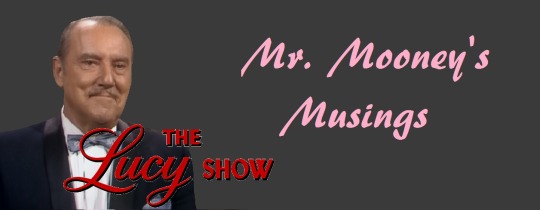
Writers Fred S. Fox and Seaman Jacobs submitted their final draft of the script on August 14, 1967.

The day after this episode first aired (November 21, 1967) stage and screen star Florence Reed died. She had appeared (uncredited) in 1937's Stage Door with Lucille Ball.

Taking a walk through the park (in heels) Lucy says to Mary Jane: “Stanley didn't hike this far to find Livingstone!” Doctor David Livingstone was a 17th century missionary and explorer in central Africa, the first European to see Victoria Falls. When reporter H.M. Stanley finally found him in 1871, he supposedly greeted him with “Dr. Livingstone, I presume?” The now famous quote was first spoken by Lucy in “Never Do Business With Friends” (ILL S2;E31) when Lucy finds Ricky through masses of hanging laundry.
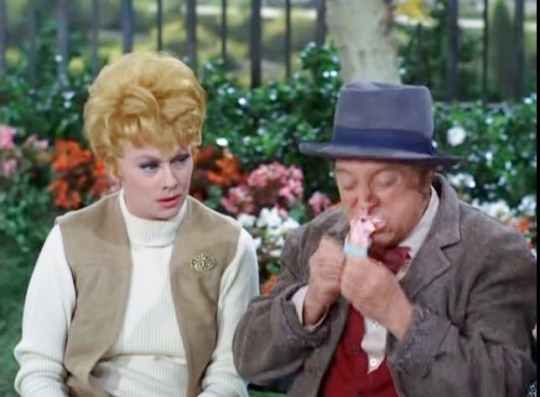
The ice cream cones Mary Jane brings buys have to be small enough for Frank McHugh to gobble up in a couple of bites, so special cones were made by the prop department.

Lucy says that if Mr. Snowden doesn't eat her ice cream cone she'll have to throw it away and probably a policeman would come by and arrest her for littering. This is the plot of “Lucy Meets the Law” (S5;E19) where Lucy the litterbug was also a suspect in a jewel robbery.

Mr. Mooney compares Mr. Snowden to Barney Baruch. Bernard Mannes Baruch (1870–1965) was an American financier and stock investor. After his success in business, he devoted his time toward advising US Presidents on economic matters and became a philanthropist.

Mr. Mooney says from the side he is often mistaken for Richard Burton, but from the front it is Rock Hudson. Both of these men were two of Hollywood's most handsome leading men. Richard Burton (with wife Elizabeth Taylor) will guest star in a 1970 episode of “Here's Lucy” as himself. Rock Hudson also played himself, in “In Palm Springs” (ILL S4;E26).

A conniving Mr. Mooney asks Mary Jane if she can keep her newspaper because he hasn't read Peanuts today. Peanuts was a syndicated daily comic strip written and illustrated by Charles M. Schulz, which ran from 1950 to 2000. The characters in the strip included Charlie Brown, Linus, Snoopy, and (of course) their own Lucy.
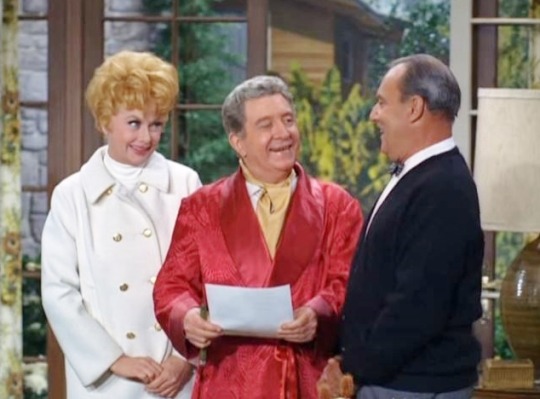
Giddy with the idea of getting rich, Mr. Mooney sings his own lyrics to Dvorak's “Humoresque”:
Twenty thousand lovely smackers
Buy a lot of cracker jackers
And I feel it landing in my lap.
Pluck! Pluck!
Lucy Ricardo sang “Humoresque” in “Bullfight Dance” (ILL S4;E22).

Lucy says that “When Mr. Mooney smells money he turns from Simon Legree to Rebecca of Sunnybrook farms.” Simon Legree is the evil slave owner featured in the Harriet Beecher Stowe story Uncle Tom’s Cabin (1852). The book was previously alluded to in “Lucy is Her Own Lawyer” (S2;E23) and “Lucy and the Countess Lose Weight” (S3;E21). Rebecca of Sunnybrook Farm is the title of a 1903 children’s novel by Kate Douglas Wiggin that tells the story of Rebecca Randall and her two stern aunts in a village in Maine. The hallmark of Rebecca’s character was her cheerful optimism in the face of adversity. It was first mentioned in “Lucy and the Winter Sports” (S3;E3) and “Lucy and Bob Crane” (S4;E22).
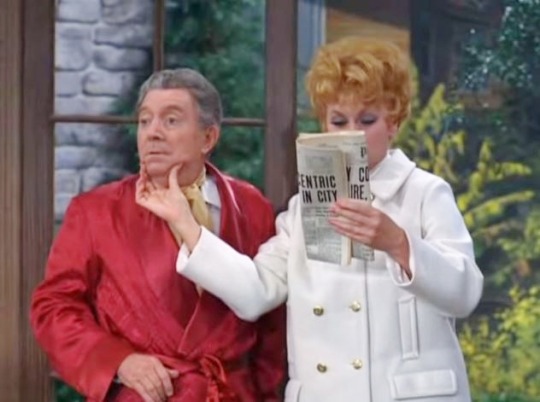
We learn that Mr. Griggs is the owner of the apartment house where Lucy and Mary Jane live.
Callbacks!
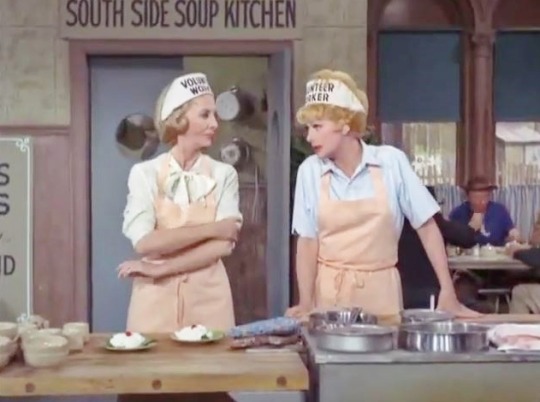
Lucy also turned philanthropist to feed the homeless by volunteering at a soup kitchen in “Lucy Saves Milton Berle” (S4;E13).
Blooper Alerts!
Mr. Snowden wipes his face after gobbling up the ice cream cone, but some strawberry ice cream remains on the end of his nose for the remainder of the scene.

“Lucy, the Philanthropist” rates 4 Paper Hearts out of 5
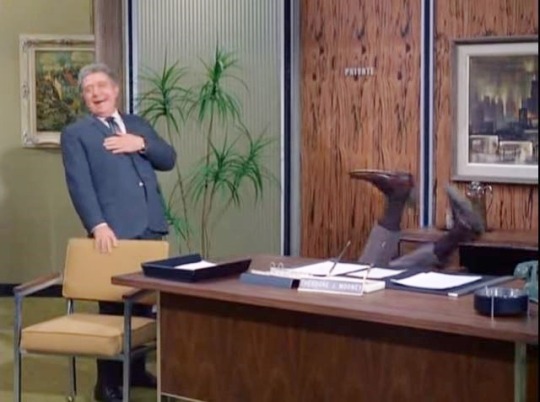
#The Lucy Show#Lucille Ball#Lucy the Philanthropist#Gale Gordon#Mary Jane Croft#Roy Roberts#Frank McHugh#Simon Legree#Rebecca of Sunnybrook Farm#Bernard Baruch#Florence Reed#Stanley and Livingstone#Richard Burton#Rock Hudson#Peanuts#1967#TV#CBS#Stage Door#Uncle Tom's Cabin
2 notes
·
View notes